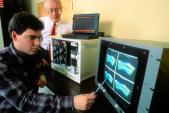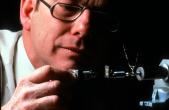As important as it was, Olympics planning wasn't a distraction for GTRI as it was for the main Georgia Tech campus. In the busy years immediately preceding the games, other research moved ahead.
In 1990, a joint project with BellSouth involved investigating personal communications services technology. The work focused on experiments and analysis to characterize the radio propagation channel inside office buildings. The long-term goal was to determine the feasibility of developing and commercializing lightweight, pocket-size telephones.
Another project — sponsored by the Redstone Arsenal and run from GTRI's Huntsville Research Laboratory — investigated the military potential of unmanned ground vehicles. Much like the bomb-handling robots used by many police departments today, the remote-control vehicle could handle ordnance in addition to scouting mine fields and possibly controlling weapons.
The durability of electro-optical components was the subject of a project that brought results in 1992 — almost six years after it started. In 1978, GTRI engineers had created a test tray of 136 items that was placed aboard NASA's orbiting Long Duration Exposure Facility.
After the tray was retrieved by the space shuttle, the components were analyzed to identify performance changes that could be attributed to exposure to the extreme space environment. The data would influence future spacecraft design.
In another NASA-related project, researchers developed new signal processing algorithms to modify existing weather radar onboard airplanes. The improved device predicts the likelihood of wind shear, which at the time was responsible for several major aircraft crashes. The project won a NASA Group Achievement Award.
In 1992, GTRI and Georgia Tech received the Cogswell Award from the U.S. Department of Defense in recognition of excellent industrial security. Only 42 other organizations received the honor that year out of a possible 11,600 candidates.
The award followed on the heels of an unannounced security audit by the Defense Investigative Service. The inspectors found zero deficiencies in either security procedures or in employees' knowledge of security requirements.
The 1990s were also a time for some of GTRI's periodic reorganizations. At the beginning of the decade, the number of labs mushroomed from seven to 22, only to be re-configured into a more manageable seven a few years later. Also, the Industrial Development Division, along with its network of regional offices, was separated from GTRI and named the Economic Development Institute. More important, from an administrative point of view, the GTRI director was named a vice president of Georgia Tech in 1991. The move was worked out between Director Grace and Georgia Tech President Crecine in an effort to more closely link Georgia Tech's academic research efforts with GTRI's applied research, thereby boosting the Institute's overall research capability. The additional responsibilities also brought GTRI to the Georgia Tech table in terms of strategic planning, technology transfer, and the emerging area of interdisciplinary problem-solving.



